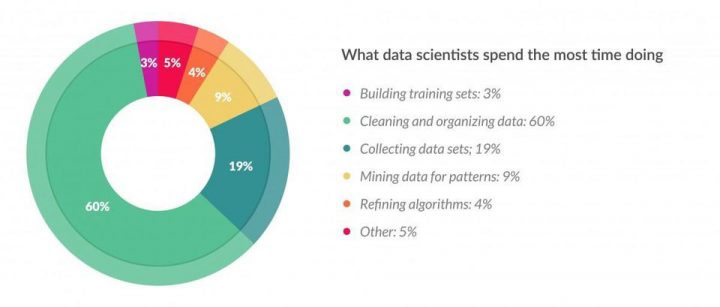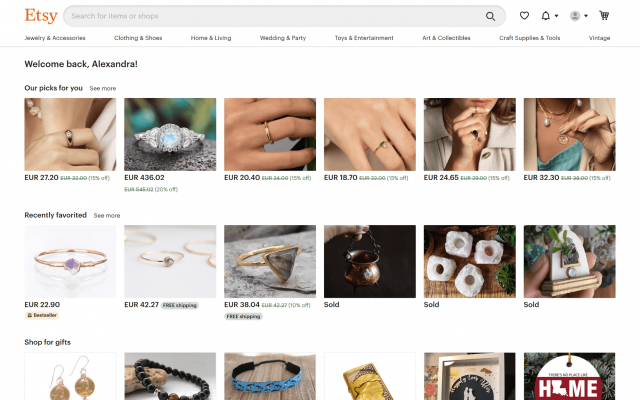Add InstantSearch and Autocomplete to your search experience in just 5 minutes
A good starting point for building a comprehensive search experience is a straightforward app template. When crafting your application’s ...
Senior Product Manager

A good starting point for building a comprehensive search experience is a straightforward app template. When crafting your application’s ...
Senior Product Manager

The inviting ecommerce website template that balances bright colors with plenty of white space. The stylized fonts for the headers ...
Search and Discovery writer

Imagine an online shopping experience designed to reflect your unique consumer needs and preferences — a digital world shaped completely around ...
Senior Digital Marketing Manager, SEO

Winter is here for those in the northern hemisphere, with thoughts drifting toward cozy blankets and mulled wine. But before ...
Sr. Developer Relations Engineer

What if there were a way to persuade shoppers who find your ecommerce site, ultimately making it to a product ...
Senior Digital Marketing Manager, SEO

This year a bunch of our engineers from our Sydney office attended GopherCon AU at University of Technology, Sydney, in ...
David Howden &
James Kozianski

Second only to personalization, conversational commerce has been a hot topic of conversation (pun intended) amongst retailers for the better ...
Principal, Klein4Retail

Algolia’s Recommend complements site search and discovery. As customers browse or search your site, dynamic recommendations encourage customers to ...
Frontend Engineer

Winter is coming, along with a bunch of houseguests. You want to replace your battered old sofa — after all, the ...
Search and Discovery writer

Search is a very complex problem Search is a complex problem that is hard to customize to a particular use ...
Co-founder & former CTO at Algolia

2%. That’s the average conversion rate for an online store. Unless you’re performing at Amazon’s promoted products ...
Senior Digital Marketing Manager, SEO

What’s a vector database? And how different is it than a regular-old traditional relational database? If you’re ...
Search and Discovery writer

How do you measure the success of a new feature? How do you test the impact? There are different ways ...
Senior Software Engineer

Algolia's advanced search capabilities pair seamlessly with iOS or Android Apps when using FlutterFlow. App development and search design ...
Sr. Developer Relations Engineer

In the midst of the Black Friday shopping frenzy, Algolia soared to new heights, setting new records and delivering an ...
Chief Executive Officer and Board Member at Algolia

When was your last online shopping trip, and how did it go? For consumers, it’s becoming arguably tougher to ...
Senior Digital Marketing Manager, SEO

Have you put your blood, sweat, and tears into perfecting your online store, only to see your conversion rates stuck ...
Senior Digital Marketing Manager, SEO

“Hello, how can I help you today?” This has to be the most tired, but nevertheless tried-and-true ...
Search and Discovery writer
A recommender system is, in layperson’s terms, software that filters down users’ choices and provides them with the most suitable suggestions based on their requirements or preferences.
The first recommender system was created in the 1970s, in the research community at Duke University; it was then developed by Xerox Palo Alto Research Center. When the Internet came into existence in the 1990s, recommender systems were immediately adopted as the way to help people select the most suitable products from a plethora of available options.
Since then, recommender systems have become more and more popular, and they now play a critical role for big Internet companies such as Facebook, Amazon, Netflix, Google, YouTube, and Tripadvisor, venturing into the realms of social networking, entertainment, ecommerce, tourism, matchmaking, and more.
In this blog series, we’re going to deconstruct the anatomy of recommendation engines, exploring what goes into building a performant one so that you’re better equipped when deciding how to integrate this functionality in your applications.
First, we need to make a distinction between non-personalized and personalized recommendation systems. With non-personalized recommendations, all users receive the same recommendations. Examples of non-personalized recommendations are popular movies, recent hit songs, and best-rated restaurants in a given location.

The most obvious operational goal of using a personalized recommender system is to recommend items that are relevant to the user, as people are more likely to buy items they find attractive.
Recommenders need to achieve four secondary goals:

A. Cold start
When insufficient information or metadata is available, a recommendation engine does not perform optimally. There are two (extreme) cold-start issues: when there’s no data about a user, which is divided into a lack of previous knowledge about the visitor and not enough information from the current session; and when there isn’t enough feedback or ratings from users. For example, let’s say a first-time visitor searches for a new smartphone on an ecommerce site. Within a week, he purchases one and is no longer interested in browsing phones. What should the recommendation engine display now?
B. Overcome data sparsity
Data sparsity stems from the fact that users on an ecommerce website tend to interact with (add an item to the cart, purchase, or review) a limited number of items. Most recommendation engines group ratings of similar users; however, the reported user-item matrix has up to 99% empty or unknown ratings because of a lack of incentives for the user to rate items or enough knowledge about an item to rate it. As a result, users who provide no feedback or ratings receive irrelevant recommendations.
C. Scalability
Scalability problems have significantly increased with the rapid growth of the ecommerce industry: modern recommendation engines are required to generate real-time results for large-scale applications. In other words, the performance of the recommendation model is measured in terms of throughput (number of inferences per second) and latency (time for each inference).
D. Diversity and novelty
The most accurate results that recommendation engines can obtain are based on user or object similarity. This, however, exposes the user to a narrower selection of items — popular ones — while highly related niche items may be overlooked. The diversity of recommendations allows users to discover items that they would not readily find themselves.

From an engineering point of view, to achieve the main goals for which it was built, the architecture of a recommender system must be scalable. There are 8 key components needed to accomplish this:
Before diving into data sources, the first thing to understand is the implicit vs. explicit nature of ratings. Feedback in the form of ratings is explicit because users select numerical values in a specific evaluation system (e.g., a five-star rating model) that specifies their likes and dislikes of various items.
In the implicit methodology of collecting feedback, a user’s browsing and purchase behavior, or their unary ratings (for example, whether they “like,” “read,” or “watch”) — in which a mechanism exists to express their affinity for an item — can be viewed as a rating signal. Today, many commercial systems allow the flexibility of providing recommendations to be based on both explicit and implicit feedback.
That raises the question, “What are the best inputs for a recommendation engine?” At the very least, you’d want to include users, items, and explicit ratings (on a five-point scale):
| USERS/ITEMS | U1 | U2 | U3 | U4 | U5 |
| I1 | 1 | ❓ | 3 | 4 | ❓ |
| I2 | 3 | ❓ | ❓ | 2 | 3 |
| I3 | 2 | 5 | 3 | ❓ | ❓ |
| I4 | ❓ | 4 | 1 | ❓ | ❓ |
| I5 | 5 | ❓ | 2 | ❓ | 5 |
While this table has a few missing ratings (indicated by question marks), in reality, less than 1% of the items are rated frequently, and those can be referred to as popular items. The vast majority are rated rarely, which results in a highly skewed distribution of the underlying ratings — effectively, we’re dealing with a long-tail property of ratings.

There are two main sources of data that one can take into consideration for a recommender system:
The aggregated data set could look something like this:
[
{
"user_id": "1",
"item_id": "100",
"events": [{
"event_1": "2016-04-20T13:25:55+02:00", //detail-page-view
"event_2": "2016-04-20T14:01:55+02:00", //add-to-cart
"event_3": "2016-04-20T14:13:55+02:00" //purchase
}]
},
{
"user_id": "2",
"item_id": "200"
},
{
"user_id": "3",
"item_id": "300"
}
]Read more on Data Sources
One of the most important and time-consuming aspects of building machine learning (ML) models is data preparation, and, specifically, feature extraction (or engineering). We all know it: 80% of the data scientist’s job is data preparation.

The feature extraction phase — in which the descriptions of various items are extracted — is highly application specific. Items may have multiple fields describing their various aspects. For example, an ecommerce business selling books might have an Item, Title, Description, Author, and Price field.
| Item | Title | Description | Author | Price |
| I1 | Later | The son of a struggling single mother, Jamie Conklin just wants an ordinary childhood. But Jamie is no ordinary child. | Stephen King | $10.88 |
| I2 | We Begin at the End | It’s set in a small town, where everyone knows Star Radley’s business—her drug addiction, the way her kids are neglected—but few extend a helping hand, besides Walk, the local sheriff who has a history with Star. | Chris Whitaker | $14.84 |
| I3 | 2034: A Novel of the Next World War | From two former military officers and award-winning authors, a chillingly authentic geopolitical thriller that imagines a naval clash between the US and China in the South China Sea in 2034–and the path from there to a nightmarish global conflagration. | Elliot Ackerman, Admiral James Stavridis USN | $17.84 |
| … | ||||
Aside from information describing each item, some recommender systems might also need user attributes (e.g., demographics) in addition to the data about the users’ ratings (implicit or explicit).
| User | Last seen | Gender | Age | Country | Pageviews | Add-to-Cart | Order Value |
| U1 | 10/01/2021 | male | 45 | Canada | 13 | 0 | 0 |
| U2 | 28/02/2021 | female | 25 | US | 5 | 1 | $129 |
| U3 | 01/02/2021 | female | 39 | France | 9 | 1 | $98 |
| … | |||||||
To address this tedious challenge in the ML life cycle, the concept of a feature store was introduced: an interface between feature engineering and model development, a centralized data warehouse of features for data science teams that solves two issues. It:

Not all recommender systems have a hard requirement of a feature store; however, when DS/ML engineers are working on multiple machine learning initiatives, manual feature engineering could cause redundancies.
So first and foremost, a feature store provides a single point of truth for sharing all available features. When a data scientist starts a new project, they can go to this catalog and easily find the features they are looking for. But a feature store is not only a data layer; it is also a data transformation service enabling users to manipulate raw data and store it as features ready to be used by any machine learning model.
Read more on Feature Store and Engineering.
The basic models for recommender systems work with two kinds of data: user-item interactions, such as ratings and buying behavior, and attribute information about users and items, such as textual profiles and relevant keywords.
Here are the basic recommender system models:
For example, consider two users, Julia and John, who are friends and have very similar tastes. If their ratings, which both of them have specified, are very similar, then their similarity can be identified by the underlying algorithm. In such cases, it is very likely that the ratings in which only one of them has specified a value are also likely to be similar. This similarity can be used to make inferences about incompletely specified values.
There are two main types of collaborative filtering:
Read more on Models.
There are scenarios in which different sources of input can be used. For example, collaborative filtering systems rely on community ratings, content-based methods rely on textual descriptions and the target user’s own ratings, and knowledge-based systems rely on interactions with the user in the context of a knowledge base. Similarly, demographic systems use demographic profiles of users to make recommendations.
It is noteworthy that these different systems have different strengths and weaknesses. Some recommender systems, such as knowledge-based ones, are more effective in cold-start settings in which a significant amount of data is not available.
Other recommender systems, such as collaborative methods, are more effective when large amounts of data are available. In many cases, when a wider variety of inputs is available, one has the flexibility to use different types of recommender systems for the same task. In such cases, many opportunities exist for hybridization: the various aspects of different types of systems are combined to achieve the best results.
Content-based filtering and collaborative filtering are often used together because they complement each other well. Content-based systems suffer from overspecialization — they tend to recommend items that are similar to other items the user has seen. Collaborative recommenders, on the other hand, cannot effectively give recommendations for new items. The two approaches are often combined in hybrid recommender systems, thereby obtaining the best of both worlds.
Read more on Hybrid Models.
At this point you’re able to generate recommendations — but how and where would you use them? For an ecommerce business, the standard approach is to display a “Recommended for you” widget on the product detail page.

Etsy is a perfect example of an ecommerce platform that uses popular items to display recommendations. Here is its home page:
Notice the central positioning of the recommendations.
The idea behind displaying popular products first is that because so many shoppers have purchased them, other people are very likely to be interested in them, too.
Although this method doesn’t really personalize the customer experience, showcasing popular items allows you to target first-time users who don’t have accounts. As a comparison, here’s what the Etsy homepage could look like after signing in:

The platform recorded all of the past product views and items added to favorites. Then it made automatic correlations with similar products from the same category or seller.
Recommender systems can also be used for cross-selling and upselling, which are aimed at helping people choose the best items for them while increasing the merchant’s revenue.
Read more on Predictions & User Actions.
Given a set of recommendation algorithms, how well do they perform? How can you evaluate their relative effectiveness?
Developers are taking care of the technical aspects, but business leaders still have a major role: deciding the page on which to test product recommendations. It can be any page, as long as you can gather enough data. Preferably, send the test to only 20% of your traffic so you don’t break the recommendations for everyone if something goes wrong. If you want to safely test any of the above recommendation systems without interfering with live data, you can have your data or web development team do tests in its sandbox.
In either case, pay attention to your KPIs and how an individual technique affects them. If you haven’t done A/B testing, your click-through and conversion rates for every single item, and not just at a storewide level, are two safe choices you can start with.
At this stage, you should not only be able to understand the benefits of using a recommender system but have an intuitive idea about the best approach for your application.
The primary purpose of AI-based ecommerce recommendation systems is to help you choose the right products to put in front of your users. Everything is backed by real data on products they’ve previously liked or shown interest in, so you’ll no longer have to guess what they might be looking for.
The future of custom product recommendation systems will allow you to target new user segments and be present everywhere: on social media, in mobile apps, in email, and of course, on your website. Simultaneously, you’ll be able to promote your entire range of merchandise, including new items, and even record data about user behavior as it occurs. So if a niche product’s popularity suddenly soars overnight, you won’t have to wait until the next morning to update your recommendations because all of this is done in real time.
This post is just the first in a series of blogs dedicated to the anatomy of a performant recommender system. Stay tuned for the next one, which will focus on data sources for recommender systems.
The AI podcast where software developers and business leaders come together to share their experience in dealing with problems that can be solved through intelligent use of data.

Powered by Algolia Recommend